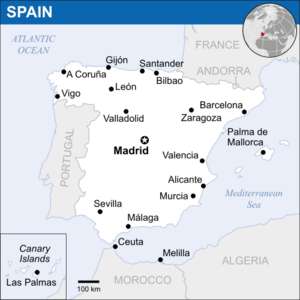Ebola virus disease in Spain facts for kids

Map of Spain
|
|
| Disease | Ebolavirus |
|---|---|
| First case | 6 October 2014 |
| Confirmed cases | 1 |
In 2014, Spain faced a challenge with the Ebola virus disease. This happened when two patients, who had caught the disease during a large Ebola virus epidemic in West Africa, were brought to Spain for medical care. Later, a healthcare worker in Spain also caught Ebola. This was due to a problem with how the second patient was treated. Luckily, the healthcare worker survived and was declared free of the virus.
Contents
First Ebola Cases in Spain
On August 5, 2014, a Spanish volunteer named Brother Miguel Pajares became sick with Ebola in Liberia. He was flown back to Spain on August 6. Sadly, he passed away on August 12.
Later, on September 21, another Spanish citizen, Brother Manuel García Viejo, also caught the virus. He was a medical director in Sierra Leone. He was brought to Spain for treatment. His death was announced on September 25. Both of these patients were cared for at the Hospital Carlos III in Madrid.
Healthcare Worker Catches Ebola
In October 2014, María Teresa Romero Ramos, an auxiliary nurse, became unwell. She had helped care for Manuel García Viejo at the Hospital Carlos III. On October 6, tests showed she had Ebola. This was the first time Ebola had spread outside of Africa. She was then moved to the Hospital Carlos III for treatment.
By October 7, doctors were watching 50 people who had been in contact with her. Seven of these people were kept in isolation at the hospital. An investigation started to find out how the virus spread.
On October 7, the government in Madrid decided to put down Romero's pet dog, Excalibur. They were worried the dog could carry the virus. Many animal rights activists tried to stop this. They even blocked the apartment. People also started online petitions to save the dog. Romero's husband, Javier, who was also in isolation, asked for help to save their dog. On October 8, Spanish officials took the dog away and put it down safely.
On October 9, three more people were quarantined by the Spanish health ministry. María Teresa Romero Ramos's condition got worse. But on October 12, she started to get better.
She was given an experimental antiviral drug called Favipiravir. The doses used were much higher than those given to other patients.
Medical staff in Madrid protested because they felt they did not have enough protective equipment. They also worried about safety. On October 17, all other people thought to be infected in Spain tested negative for Ebola.
On October 20, it was announced that Teresa Romero had tested negative for the Ebola virus. This meant the virus was gone from her body. On November 1, she was declared Ebola-free. She was moved from isolation to a regular hospital bed to finish getting well. The World Health Organization (WHO) declared Spain free of Ebola on December 2. This was 42 days after Teresa Romero was confirmed to be free of the virus.
New Vaccine Research
In July 2018, a Spanish team from the October 12 Hospital in Madrid made an important announcement. They found an antibody and developed a new vaccine. This vaccine could work against five types of Ebola, including the most common and dangerous ones.
Lessons from the Past
The Ebola cases in Spain happened when the country was led by the People's Party. The prime minister at the time was Mariano Rajoy. Later, during the COVID-19 pandemic in Spain in 2020, many people remembered the Ebola outbreak. Some politicians who had criticized the government during the Ebola crisis were now in charge during the COVID-19 pandemic. This showed how challenging it is to manage health emergencies.
See also
 In Spanish: Ébola en España para niños
In Spanish: Ébola en España para niños

